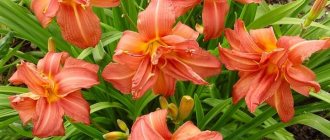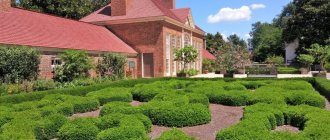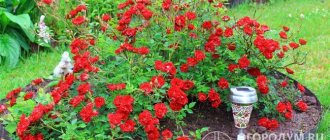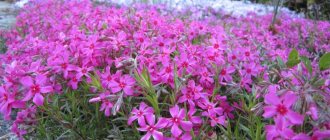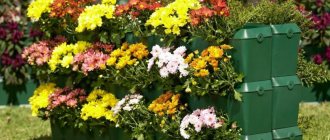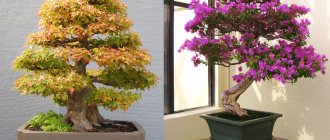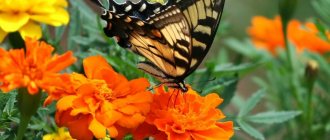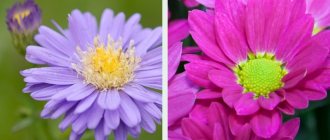The fashion for monochrome flower beds has reached our latitudes. Among all the options for a garden designed in one color, a monochrome garden in red is the most difficult to implement and the most expressive. The fiery energy of flowers and plants in red decoration gives rise to an uncontrollable desire for action and lifts your spirits. But there are certain difficulties in using red in garden compositions. It is necessary to very carefully select shades and halftones in order to avoid excessive variegation and emphasize the advantages of plants.
Principle 3. Use of plants with decorative and simply beautiful foliage in the composition
When creating a monochrome garden or flower bed, you need to remember that any flowers will fade sooner or later, and decorative foliage can decorate the flower garden until the first frost. Therefore, these plants should occupy about 40-50% of the entire flower bed. A striking example is hosta, asparagus, chistema, cineraria, amaranth, coleus, and ornamental cabbage.
Monochrome flower bed photo
Since monochromatic compositions stand out with a slightly boring monochrome, they can be diversified with flowers with different structures and different leaf shapes. Bergenia and hosta go well with plants that have openwork leaves, such as asparagus, yarrow, and fern. You can also add crops with narrow and pointed leaves here. These are daylilies, irises, daylilies, gladioli.
Landscape tricks (video)
Having an artistic taste and love for plants, you can create monochrome gardens in other equally attractive colors that will delight the eye and soothe the soul of everyone who can appreciate the versatility of one color. You can read an article about the features of designing a site in country style.
Principle 5. Use of crops with a long flowering period.
Let’s say that if a flower garden occupies an area of 3 sq.m., then 3 or 4 large plants, about 5-6 medium-sized crops and up to 10 small ones are placed on it. It turns out 20 types of different colors. For example, 4-5 bulbous plants planted in one group, with different flowering periods, form one perennial.
To minimize planting costs, preference should be given to perennials. There should be 50% of them in the flower garden, or better yet 2/3. That is, about 10-12 plants in a flower garden should be perennial. But in this situation, another problem arises: not all perennials bloom for a long time. The flowering period for many of them lasts 2-3 weeks. And there are only 2-3 types of plants that bloom for a longer period. Therefore, when choosing plants for a flower garden, you need to choose those crops that have a longer flowering period.
Therefore, it will not be possible to create a flower garden only from perennial plants, since perennials are significantly inferior to annual crops in terms of flowering time.
Optimism of the orange garden
The color orange is associated with sunshine, warmth and a feeling of celebration.
A garden in such rich colors will add light and color to every corner of your garden plot. It is believed that this color stimulates mental activity, cures depression and even stimulates the digestive system. However, too much exposure to orange flowers can lead to insomnia and headaches. We recommend reading the article about the prairie garden.
To create a garden with an orange mood, the following tips on choosing and placing plants in the area allocated for them may be useful:
- To decorate flower beds, flower beds, rock gardens, gazebos and mixborders, you should choose plants not only with an orange color, but also with shades of yellow. With the correct placement of plants, you can achieve a golden shimmer effect.
- Interspersed with purple and rich blue colors will highlight the luxuriousness of yellow-orange shades. At the same time, you need to ensure that the orange color is not suppressed by its floral companion.
- To create an orange garden, lilies, decorative varieties of calendula, marigolds, sandersonia, eschscholzia, iris, as well as daylilies and lushly flowering varieties of roses in fiery shades are perfect.
- To decorate the gazebo, you can use nasturtiums planted in an elegant flowerpot.
- The rock garden will be decorated with unpretentious rock alyssum and lush vinidium, and fragrant marigolds are often used to decorate borders in orange gardens.
- In autumn, such garden compositions will be decorated with a variety of shrubs and trees, crowned with a crown of flaming foliage.
Principle 6. Combination of shrubs with perennials, annual crops and bulbous plants.
This law is relevant only for a large monochrome composition, where some kind of shrub is taken as a basis, and other flowers are added based on it. Most shrubs retain their decorative appearance throughout the season. They create a good background for most herbaceous plants. They do not require special care. The disadvantage of the presence of shrubs in the composition is the short flowering period. But this drawback can be overcome by the decorativeness of the leaves.
Shrubs
Speaking about shrubs, it is worth mentioning roses, which will fit perfectly into any monochrome composition. Roses in a flower garden should always stand out, otherwise their beauty will fade against the background of other flowers. This is especially true for large classic roses.
A climbing rose on an arch at the entrance to a flower garden will decorate any composition, as will small border roses. they are always appropriate and always look great.
There is one plant that is quite difficult to fit into a monochrome composition - rhododendron. Despite the abundance and duration of flowering, it is not entirely suitable for creating a flower garden. After all, for comfortable growth of azaleas, acidic soil is required. She looks best in splendid isolation. Other garden plants can get lost against its background.
Blue flower bed
Bulbous plants
It is the bulbous flowers that start in early spring. Therefore, to prevent the flower garden from looking gloomy in the spring, they should be added to the composition. These crops require a lot of energy. They need to be dug up for the winter, stored, and planted in the spring. There are bulbous plants that do not need to be dug up. They are quite unpretentious and can easily live in one place year after year. Such plants include crocuses, scillas, snowdrops, hazel grouse, daffodils, and pushkinias.
There are varieties of tulips that do not require annual digging. They can exist in one place for a long time. These varieties include “Foster”, “Kaufman”, “Greig”, “Darwin hybrids”, and wild tulips.
Summer-flowering and fairly unpretentious bulbous plants include lilies. They can live safely without a transplant for up to five years. Colchicum is also an unpretentious bulbous plant.
Blooms in autumn. Blooms only in pink and white. The following bulbous plants have a wide variety of shades: gladioli, dahlias, begonias. When planting these plants, the bulbs are dug up for the winter and stored in a cool room.
Monochrome flower beds
The unstoppable energy of a red monochromatic garden
Red color is quite energetic and leading. He is able to charge strong people with his powerful energy. At the same time, its excessive amount in garden plantings can cause a feeling of fatigue. Therefore, it is recommended to use red flower beds in the form of separate inclusions, as well as as accents of garden decoration and delineation of its individual zones. In addition, you should know that red color optically reduces the space of a personal plot, so for small areas it is better to choose a different color to create the necessary monochrome landscape compositions.
To eliminate the intrusiveness of red when creating flower beds and flower beds, it is recommended to use contrasting shades of this color: scarlet, burgundy, pink, etc.
For the most harmonious combination of plants for a red garden, dachadecor.ru recommends adhering to the following recommendations:
- To create a mixborder in red tones, plants such as daylily, bearded iris, hydrangea, cellosia paniculata and comb, snapdragon, lupine, blooming in various shades of red, are best suited.
- In the flowerbeds of the red garden, burgundy astilbe, ever-blooming tuberous begonia, inimitable peonies, touching buttercup, passionate poppy and shy hazel grouse will become a real decoration.
- To create a landscape design in red tones, you should use not only flowering plants, but also trees, as well as shrubs, the crown of which is painted in all shades of passion and energy. In the fall, they will act as the final chord of a bright and rich symphony of color. Purple apple tree, common hazel, winged euonymus, Norway maple and common mackerel will fit very harmoniously into a composition in red tones. A magnificent scattering of autumn berries will complement the composition with barberry, rowan, viburnum and even rose hips.
The red color can sparkle with unusual colors if it is complemented with plants from a different color scheme. In order to achieve a cooler shade of red in close proximity to similar plants, you should plant angustifolia lavender, decorative varieties of wormwood, and Italian cinnamon, which, with their silvery foliage, give the flower garden a unique effect. To expand the visual perspective, a red monochrome garden should have blue splashes.
Herbaceous perennials
Plants of this species are durable and unpretentious. They can serve as both the basis of a flower garden and its background. In the assortment of perennials there will always be flowers for the middle and front arches. Flowers of this group bloom for 2-3 weeks. In April, liverwort, lumbago, sedum, and asters begin to bloom.
Annuals
The gap that appears between the flowering of perennial plants can be filled with annuals. These plants are easy to care for, and they bloom throughout the summer.
Refer to temporary solutions
Even if it seems to you that the monoflower fits perfectly into the overall appearance of your garden, do not rush to bring your idea to life, but arrange a temporary flower garden. Using bulbous and annual crops, you can appreciate the benefits of a particular color.
For example, some gardeners are not too fond of blue, considering it a cold or even somewhat depressing color. Meanwhile, in nature, truly pure and clear tones are almost never found. It’s interesting that some shades of blue even got their names after flowers: lilac, cornflower blue, lavender, periwinkle?
If, at the end of the flowering season, you come to the decision that such a spot of color would be appropriate, you can begin to develop a more “large-scale canvas”, but, quite possibly, with the participation of other plants.
Flowers that will help create a blue-blue flowerbed: ageratum, aconite, bellflower, periwinkle, cornflower, speedwell, hyacinth, muscari, gentian, large-leaved hydrangea, delphinium, creeping tenacious, morning glory, nutwing, clematis, crocus, lavender, lobelia, flax, forget-me-not, petunia,
On a note
- For a monozone, choose plants with the longest decorative period.
- It is better to take not one variety, but several with different flowering periods.
- A flower garden that is too small will be lost (the game will not be worth the candle), if it is too large, it will quickly become boring with monotony. Look for a middle ground.
- In a mass of flowering, a plant can produce a completely different effect than in a single planting. Before you design a large monozone, experiment with a small one.
- If the composition is too catchy, choose a green frame for it from cereals, ground covers, and decorative deciduous perennials.
The beauty of hydrangea is emphasized by a border of phalaris
As you can see, even a single plant can become the basis of an exquisite composition and the highlight of your garden. When ordering a landscaping project, tell the landscape designer about your preferences, and he will offer interesting and stylish solutions.
Delicate pink flower garden
Romantic pink captivates with its nostalgic charm. A flower bed made in this color must be lush, voluminous, as natural and landscape as possible; it is appropriate in gardens with nostalgic charm or in landscape styles. You can install a sculpture or fountain on it, emphasizing the character of the garden design.
In addition to the traditional queens of pink flower beds - roses, perennials such as peony, Japanese anemone, physostegia, Echinacea purpurea, gypsophila and annual zinnias, cleome prickly, snapdragons, grey-headed leaves, lavatera, and cosmos bipinnate will easily fit into the palette. Double roses bring romantic picturesqueness to flower beds, while non-double roses add lightness and airiness.
It is very easy to create a flower garden with a romantic accent. An ideal candidate for the background is hollyhock, or mallow, in the palette of which you can find both rich and light shades of pink.
First, background plants are planted, then soloists - roses or peonies, and the rest of the space is filled with large groups of non-repeating plants. Lush cushions of Endris geranium and small lobularia marine will make a magnificent contrast with the gramophone flowers of the middle bell or lavatera in the foreground. In the middle of the flower bed, scarlet tansy and paniculata phlox will sparkle with new colors, and lush hybrid monardas will happily keep them company. Elegant nemesia will highlight accessories and sculptures with elegance.
Selection of plants
The choice of plants for monozones is huge and is limited only by your preferences and the tasks that they must solve.
Of the shrubs and perennials for these purposes, those most often used are those that have a wide variety of varieties and colors. These are roses, rhododendrons, mock orange, hydrangeas, peonies, lilies, etc.
By selecting rhododendrons with different flowering periods, you can create a monozone with a long-lasting decorative effect.
Annuals that bloom brightly and continuously for 3-4 months are also popular - petunia, marigolds, salvia, begonia, asters.
The main advantage of annuals is their unpretentiousness and long flowering.
A separate group consists of plants for seasonal cultivation. They delight the eye in the spring and then disappear completely. These include tulips, hyacinths, crocuses, daffodils, violets, primroses, and muscari.
Modular monoflower bed of tulips and hyacinths
Collectible monozones, created to discover the beauty of one plant species, deserve special attention. A large part of the garden or a small corner may be devoted to a variety of varieties, but they always become a source of special pride for the gardener.
The most common types of such monogardens are rosaries (roses), gladularia (gladioli), peonaria (peonies), lilinaria (lilies), iridaria (irises), phloxaria (phloxes).
In the photo - floxarium
